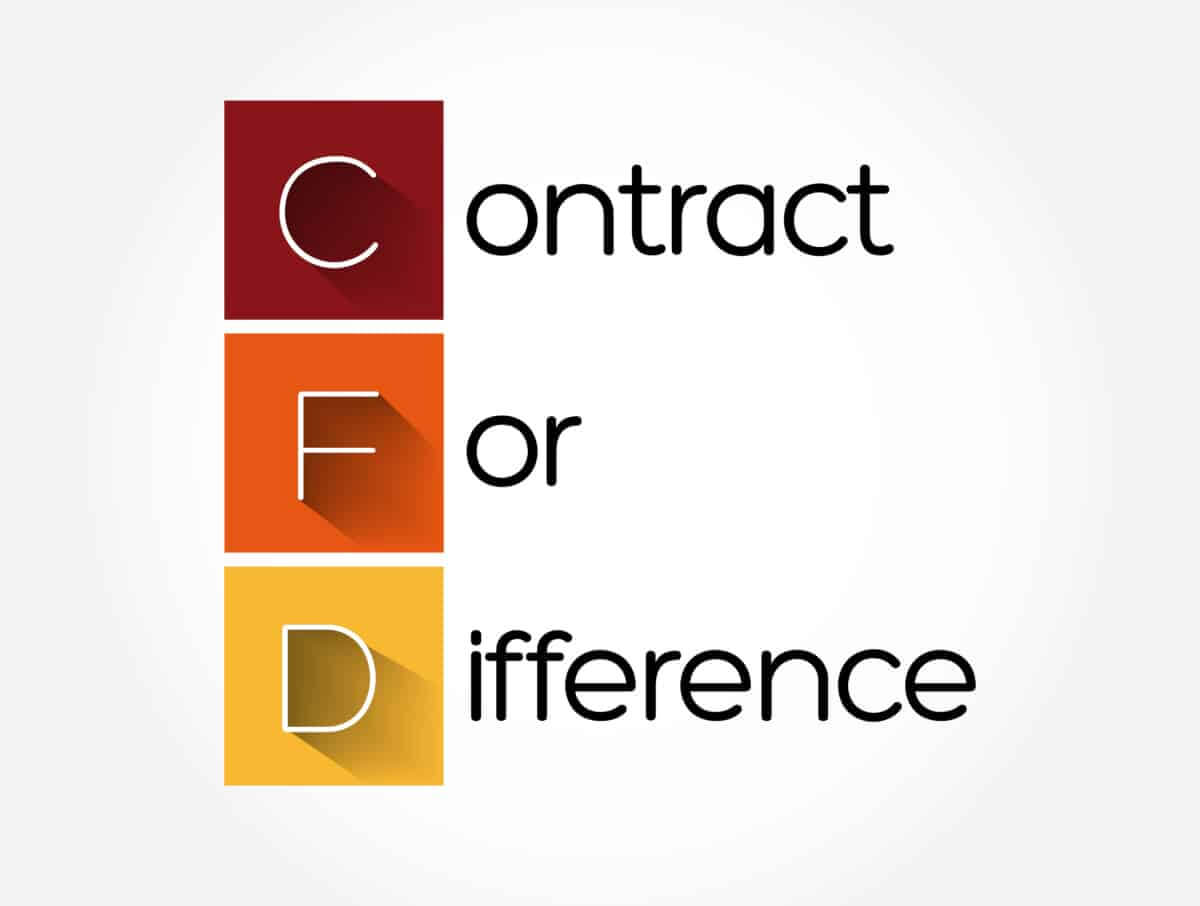
What are CFDs?
If you are looking into the world of trading, you may have come across the term CFD. CFD stands for contract for difference. It is an incredibly useful tool for investing in a particular market without putting too much at risk.
A newcomer to the world of trading can reap great benefits from using them. So, what are they? To put it briefly, they are a type of derivative. You may then ask yourself, what are derivatives?
Derivatives
A derivative is a type of contract that does not require the party involved to own any assets. Instead, the party will consider the price of an asset and consider where they think its price will go. They will then base their contract on the current and predicted future price of said asset. Essentially, they are making a bet on the price movement of the asset.
This is highly beneficial, as said party will never have to own the asset, so will not have to convince anyone to trade said asset with. All they have to do is come to terms with another party beforehand, and once the conditions of the contract are fulfilled, the trade can go through.

So, if you are correct with your predictions, you should be guaranteed a trade. The other great thing about derivatives is that you can base them on any asset.
Since you aren’t restricted to paying the incredibly high prices of, say, stocks, you will be able to benefit from their price change without paying for them. So assets usually not available to you will suddenly become worthwhile investments.
Finally, you can start trading in CFDs for very low prices because, as we said, you don’t need to pay the full price of an asset.
History of CFDs
Contract for Difference (CFD) is a financial derivative instrument that allows traders and investors to speculate on the price movements of various underlying assets without actually owning the assets themselves. CFDs have a relatively short history, having emerged in the early 1990s, primarily as a tool for institutional investors. Since then, CFDs have gained popularity worldwide due to their flexibility and potential for profit.
The concept of CFDs was first developed by Brian Keelan and Jon Wood at UBS Warburg, now known as UBS Investment Bank. They created CFDs as a way for institutional investors to hedge their exposure to stocks on the London Stock Exchange. The idea was to provide a more efficient way to manage risks associated with traditional stock trading.
CFDs in the United Kingdom
CFDs gained regulatory approval in the United Kingdom in the early 1990s, and they quickly spread to other parts of Europe. One of the key features of CFDs is that they allow traders to profit from both rising and falling markets, as they can take long (buy) and short (sell) positions on various assets, including stocks, commodities, currencies, and indices.
As CFDs became more widely adopted, they attracted retail investors as well. The availability of online trading platforms and the ability to trade CFDs on a wide range of assets made them accessible to a broader audience. Retail traders were drawn to CFDs because they offered leverage, enabling them to control larger positions with a relatively small amount of capital. However, the use of leverage also increased the potential for significant losses.
CFDs have faced regulatory scrutiny and changes over the years, with authorities in various countries implementing rules to protect retail investors. These regulations often include measures to limit leverage and increase transparency in pricing and risk disclosure.
Despite regulatory challenges, CFDs continue to be popular among traders and investors worldwide. They provide a convenient way to speculate on financial markets without the need for physical ownership of assets, and they offer flexibility in terms of trading strategies. However, potential traders should be aware of the associated risks and carefully consider their trading approach and risk management strategies when engaging in CFD trading.
Basics of CFDs
So, with all that out of the way, onto the main topic of our article. What are CFDs, and how are they different from other derivatives? The main attraction of CFDs is that they do not have a set expiry date.
This means that traders can finish a trade whenever they feel ready. They can wait for the value of the asset that they desire and then complete the trade. This is of great benefit to the trader, as it more closely resembles the realities of real trading.
Many times, the value of an asset can be just at the wrong place, at the exact times that a contract expires. A CFD allows you to circumvent slight hiccups like this.
Much like most derivatives, the prices you pay for a CFD can be very low, as low as $1,000 in some cases.
The people who usually deal in CFDs are brokers. The details of the contracts themselves can be a little complicated, especially if you have only started. The market for CFDs are also highly unregulated and do not appear in exchanges. This is why a broker is the best option if you want to deal with these trades.

Lack of regulations for CFDs
The lack of regulations in the market can be a double-edged sword. On the one hand, you can pretty much set up any sort of trade you desire with the help of a broker, but on the other hand, you have nothing to fall back on if your trade was less trustworthy.
This is why finding a trusted broker is of utmost importance when deciding on investing in a CFD.
The lack of comprehensive regulations for CFD trading has been a point of concern in the financial industry. While some countries have implemented regulatory measures to address specific aspects of CFD trading, there is no globally standardized framework governing CFDs. Here are some key issues related to the lack of regulations for CFDs:
Investor protection: The absence of consistent regulations can leave retail investors exposed to significant risks associated with CFD trading, including high leverage, complex pricing structures, and potential conflicts of interest with brokers.
Risk of excessive leverage: One of the main concerns is the availability of high leverage in CFD trading, which can amplify both gains and losses.
Inadequate risk disclosure: Regulations in some jurisdictions require brokers to provide detailed risk disclosures to clients. However, in regions with less stringent oversight, traders may not receive sufficient information about the complexities and risks of CFD trading.
Lack of consistency: Regulations for CFDs vary significantly from one country to another, creating a lack of consistency and making it challenging for traders to understand the protections (or lack thereof) available to them.
Market integrity: Without robust oversight, there is a risk of market manipulation or unethical practices.
Trading on margin
The other benefit of investing in CFDs is that brokers often offer trading on margin or leverage. What does this mean? To put it simply, brokers will allow you to make trades with a loan.
So the margin of a trade is the price you will have to pay out of the entire investment. The margin for CFDs can vary considerably, from 1 to 20%. This means that you can pay a very small portion of the full investment of a CFD. If you do want to make larger investments, the potential full investment can be that much higher.
This allows you to make much larger profits, as the only additional fee you need to pay is the interest on the loan. You are not required to pay the profits made with the loan to the broker.
The lack of an expiration date does come at an unfortunate cost. If the value of an underlying asset is going in the opposite direction to which you wanted, you will have to pay a premium. A broker may worry about the potential failure of your investment so will need something to reassure them. This premium is known as a margin call.
The cost of brokers
Brokers also have several forms of payment. This usually includes commissions (usually low), spreads, and flat fees for things like marketing and advice. If you are new to trading, you may not yet be familiar with how spreads work.
Basically, there will be a slight difference between the price you pay a broker for a trade, and the actual price of a trade. They will make you pay a little more when you buy, and give you a little less when you sell. They will then make a profit from these small differences.

In the world of CFD trading, spreads can be quite large. All of these fees for a broker can stack up and leave you with considerable fees. This is why if you are investing in CFDs unless you are sure you are making a great investment, your net profits will probably be low. This is especially true if you are paying the minimum prices without margin.
Education and CFDs
Educating yourself about Contract for Difference (CFD) trading is essential before venturing into this financial derivative market:
- Basic Understanding: Begin by grasping the fundamental concept of CFDs. They are derivatives that allow you to speculate on price movements of underlying assets without owning them.
- Risk Assessment: Recognize that CFDs involve high risk due to leverage, potentially leading to significant losses. Assess your risk tolerance and financial capacity accordingly.
- Market Research: Gain insights into the financial markets where CFDs are traded, including stocks, indices, commodities, and currencies. Understand how various factors impact asset prices.
- Trading Strategies: Explore different trading strategies, such as day trading, swing trading, and position trading. Learn how to analyze charts, use technical indicators, and conduct fundamental analysis.
- Risk Management: Develop a robust risk management plan that includes setting stop-loss orders and managing your position sizes to protect your capital.
- Regulation: Understand the regulatory framework in your region and choose a reputable, regulated CFD broker.
- Continuous Learning: Stay updated on market developments, trading techniques, and risk mitigation strategies. The CFD market is dynamic, and ongoing education is vital for success.
- Practice: Consider using a demo account to practice CFD trading without risking real money until you’re confident in your abilities.
Remember that CFD trading requires discipline, patience, and a well-thought-out approach. Continuous learning and risk management are key to becoming a successful CFD trader.
Conclusion
-
Support
-
Platform
-
Spread
-
Trading Instrument




